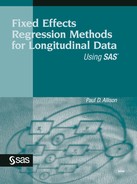Praise from the Experts
"The power of fixed effects models comes from their ability to control for observed and unobserved time-invariant variables that might confound an analysis. As knowledge of this feature of fixed effects models has spread, so has the interest in using these methods. One obstacle to further use has been the lack of accessible and consolidated information on fixed effects methods in diverse models such as linear regression, categorical and count regression, and event history models. A second obstacle to wider use has been insufficient knowledge of the software to implement these techniques.
"Paul Allison's Fixed Effects Regression Methods for Longitudinal Data Using SAS® goes a long way toward eliminating both barriers. This book is a clear, well-organized, and thoughtful guide to fixed effects models. There are separate chapters devoted to linear regression, categorical response variables, count data, and event history models. These models represent the most widely used ones in the social sciences. In a brief monograph, Allison is able to present the essentials of fixed effects for each model and the appropriate procedures in SAS that can implement them. Empirical examples and SAS code are included, making it easier for the reader to implement these methods.... In sum, Paul Allison has produced a terrific guide to fixed effects models and their estimation using SAS. I highly recommend it."
Kenneth A. Bollen
Immerwahr Distinguished Professor of Sociology
Director, Odum Institute for Research in Social Science
University of North Carolina at Chapel Hill
"Fixed Effects Regression Methods for Longitudinal Data Using SAS represents an excellent piece of work. It is clear, coherent, well-structured, useful, and has a sense of logical flow not always found in efforts of this sort. To say that I was impressed with this book would be an understatement.
"What I especially liked about the book was how Allison is able to fluidly mix clear and accurate explanations of statistical concerns and procedures with specific directions for how to go about these procedures in SAS. It merits observing that even researchers or students not thoroughly versed in the statistical underpinnings or mathematical complexities will be able to analyze and interpret their data using the directions provided. The author even provides sample outputs and takes the reader through a scholarly interpretation of results."
Frank Pajares
Professor of Educational Psychology
Division of Educational Studies
Emory University
